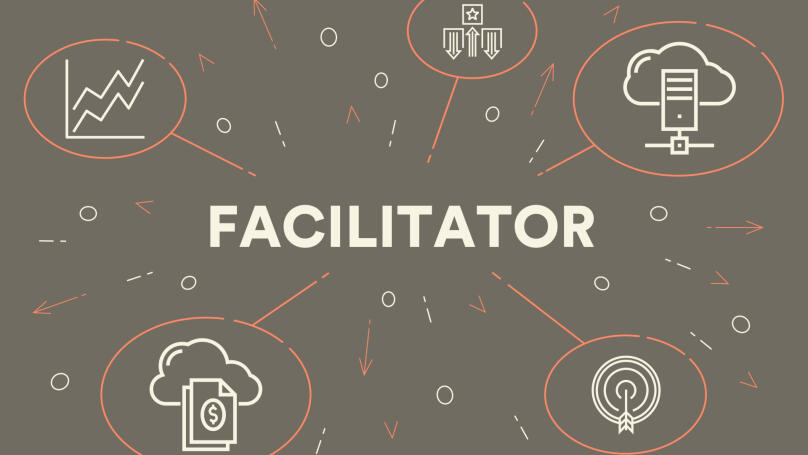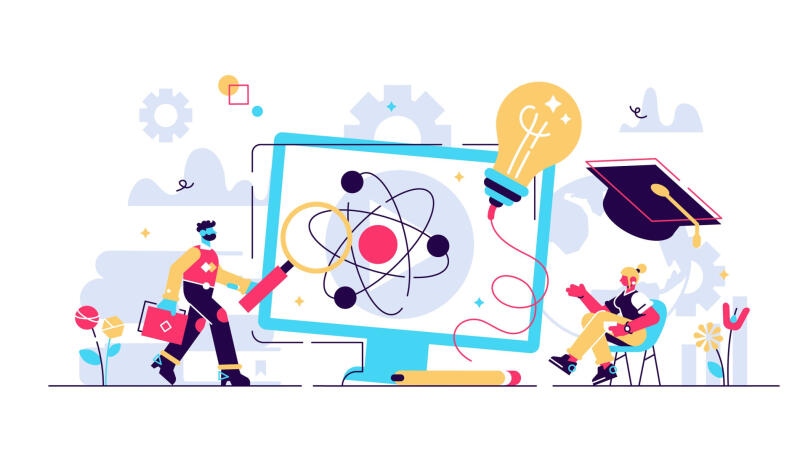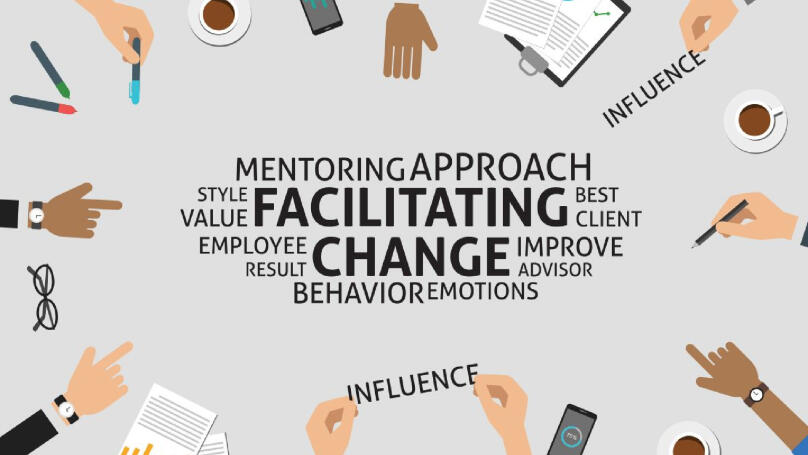Facilitation

What is facilitation?
Facilitation represents a group of tools and techniques that allow you to effectively discuss problems within a group. The definition literally means "facilitating the process", as a facilitator leads the discussion, helping the participants to have a productive and positive state of mind and monitoring the conversation's progress. Facilitation is often used in education and psychology. Its meaning suggests that facilitation technology can be used in pedagogy, at-work meetings for journalists, brainstorming sessions, and board meetings.
The first time that Facilitation was ever mentioned was back in 1965 when an American psychologist Robert Zajonc experimented with… cockroaches. The study indicated that cockroaches could navigate simple mazes better when paired and supervised by other cockroaches. However, cockroaches easily completed more complex mazes whenever they did this alone and without extra spectators. This "moderation effect" interested the psychologist. As a result, he conducted several more experiments and discovered that moderation affects people similarly. This is how social facilitation appeared: Robert realised that work environments impacted its quality. In the 1980s, this theory was introduced into education and moved into business afterwards.
Today, facilitating meetings is, of course, no longer about cockroaches. Instead, it is all about knowing the rules, having an unreservedly cheerful outlook towards all participants throughout the process, and having a fine-tuned vision and skills.
Who is the facilitator?
The facilitator is someone who leads the discussion, draws up its rules, ensures they are followed, and guides the participant's conversation in the right direction. They need to organise the meeting, describe how to work with different tools, deal with any conflict, and manage any dominance or opinions of several respected participants. The facilitator takes a neutral stance and does not express their opinion, even if they are asked to do so.
A facilitator can be a consultant from a consulting company or an employee not personally connected to solving the problems facing the department or the group of people. After all, their interest may cause them to support a certain opinion without thinking.
Skills the facilitator needs

Facilitator skills include:
- Time management. Time management is crucial to obviously meet the time limit for any discussion.
- Active listening. Without it, a facilitator cannot effectively moderate sessions. This skill is part of the overall set of empathic skills. You must maintain eye contact, be relaxed, keep your finger on the pulse, and stop yourself from assessing any opinions voiced. It will be hard for a person who wants to speak up quickly because the role of the facilitator, among other things, is to not interfere in a conversation or monologue.
- The ability to ask questions. Suppose the facilitator is afraid to ask, interrupt and clarify anything from the participants during the meeting. In that case, the result of the discussion may not turn out the way they would like. Therefore, questions should be open-ended - they should not be answered with a simple "yes."
- Impartiality. The more removed a facilitator is from the topic of the conversation, the better. It is vital to remain impartial and not critical.
- Adaptable. The conversation probably won't go according to plan because of whoever is present, including different personalities and motivations, so the facilitator must adapt to any events. You can create several meeting scenarios in advance so you don't get confounded if things don't go according to plan.
- Communication skills. You will interact with various people, so your communication skills (and the ability not to lose your temper quickly) will be useful. Incidentally, this also includes using non-verbal language: gestures, movements, and facial expressions. Creating an atmosphere where participants are included in the discussion process is also part of a facilitator's communication skills.
- Understanding the dynamics of a conversation. This quality helps eliminate inequalities in the group and balance roles. You should evaluate the group's energy and learn how to support it, no matter how esoteric it might sound. You need to be able to lower your energy levels or develop them, which requires training and practice.
The functions of a facilitator
What does a facilitator generally do during a discussion? Usually, they perform the following functions:
They should NOT:
- Behave like an expert. The facilitator should not push anyone into a solution that they prefer.
- Lose sight of emotions. As we have already said, the emotional component is responsible for much of the success.
- Allow the conversation to flow chaotically. The discussion should be regulated and structured; this is the facilitator's responsibility.
- Disregard any ideas. Every suggestion and decision should be written down.
- Independently interpret the words of the participants during the conversation. It would be better to ask the members of the discussion themselves.
- Demotivate.
They should:
- Supervise the discussion. You can use the tools and methods we have already discussed to achieve this.
- Maintain the focus of the group. Getting the conversation members to answer questions without being distracted by unrelated topics would be beneficial.
- Ask questions, listen, and hear.
- Engage each participant in the discussion. The option of "Participant agrees with the opinion of the others" is impossible.
- Monitor the decision-making process. Everyone's voice should be valued!
The stages of facilitation

Any strategic session, and discussion about innovative ideas and ways to put them into practice, involve breaking down facilitation into several stages. Most commonly, the following series of actions are highlighted:
- Opening a session
Here the facilitator speaks about the goals of the meeting, the topics, questions regarding them, and the rules of the discussion. They must create a comfortable environment for honest communication to ensure all participants understand the meeting rules. It is essential to explain why it is taking place and how decisions taken will affect the development of the business or organisation.
- Generating ideas
The group considers their problem-solving options and creates and develops strategies to solve them. You can use all the methods and techniques that were described earlier.
- Choosing a pool of solutions
The facilitator invites the participants to discuss the solutions developed during the previous stage and select the best ones. All opinions are logged.
- Developing an execution plan for the solutions that are selected
The group members organise the information and prepare an execution plan for the decisions. It is better to define what must be done, what the time limit is, what resources will be needed, what the outcome of the actions might be, and how these results will be evaluated.
- Ending a session
Here the facilitator thanks all the session members for participating in the discussion and asks them to share their thoughts or opinions about the meeting.
Facilitation methods
What facilitation methods should you learn as a beginner?
- Group focus
Group facilitation centres on a united course and an initial development route. It is the facilitator's responsibility. Group focus requires regular reminders about the aims of the discussion and how talking through this brings the company or project closer to a specific goal. It also includes summarising the provisional results and issuing instructions during the conversation. In simple terms, group focus is a method of keeping the entire group's attention on the topic of discussion. The facilitator won't allow the group to take the conversation down a different route as though distancing themselves from the general meeting.
- Recording the results of the work
At a specific time (appointed in advance and depending on the speed of the group's work) you need to record the provisional results of the discussion. This can be done orally or in writing. Generally, it is advisable to use a written version: on cards, flipcharts, in a separate notebook, or on the whiteboard in the room. The individual who came up with the result can also record it.
- Gathering opinions
Facilitating group work involves having at least two opinions. These views must be appropriately identified and gathered, highlighting vital information. It helps to involve the participants in the discussion, talk to them carefully, and use emotional intelligence to understand their deepest motives and appeals. The higher the quality of the facilitator's work, the higher the productivity of the group and the quality of the opinions of its members.
The rules for gathering information are usually the same: you should use several types of questions, conduct brainstorming sessions, collect individual moderation cards, and subsequently rate them. However, facilitator skills enable you to tackle all these points brilliantly.
- Achieving common ground
The principles of facilitation always include reaching a consensus. Therefore, the facilitator should create a process that focuses on reaching an agreement that considers each participant's thoughts in the discussion, leading to a decision that the whole group can get behind. This can be challenging, and the participants in the meeting could have completely different opinions that contradict each other. So, the facilitator must be prepared because the discussion could become extremely heated.
The facilitator collaborates with individuals with their own motivation and manages intra-group practices. A crucial aspect is maintaining high energy levels to engage participants in active work. Keeping individuals energised can be achieved by changing the pace of the discussion, taking timely breaks, and considering natural energy levels (for example, some work better in the afternoon and others in the morning).
A facilitation professional must address the unconstructive behaviour of group members in one way or another. And expressions of this behaviour will have to be waded through, so the role of the facilitator in the team is incredibly important.
Facilitation techniques

The benefits of facilitation lie in many techniques used across various industries. What other ways of facilitation currently exist today?
- Moderation cards
This is a method for collecting opinions. Moderation cards look like ordinary cards, which suggest, for example, answers to questions or options for solving a problem. After the participant hands in the cards, the facilitator examines them, combines the ideas, and expresses them. You can ask for clarification from the person who has put their opinion on the card. All disputes can also be visualised with the help of these cards.
- Mind maps
This is a method for generating ideas (It is also a tool - it is important not to be confused by this). Mind maps are required for an in-depth study of a subject. When using this method, you will need a board where you can draw a circle with the key issue. Then you can draw arrows from the circle to other circles to capture ideas, place them next to the main topic, search for subtopics, and develop the map from a general topic to a specific issue. Finally, each subtopic can be explored by asking participants questions.
- Voting to rate the information
It is a voting method for organising suggestions from the most interesting to the least interesting group. A critical skill of a facilitator is to avoid insisting on a solution to the problem that seems most relevant to them. Voting happens the same way as always: the group members mark whether they agree with the proposed option or not, and if they do, then to what extent (taken as a percentage)? You can vote offline using sticky labels or online using any appropriate service.
- Predicting
This is a method for creating multiple solutions to an issue. It is used when the group is unsure about the suggested solution, particularly when obstacles have made the situation seem impossible. Participants will need to imagine that now is the same time of day. However, one year from now, all plans and decisions have been implemented, and the problem has dwindled into the background. Subsequently, you must look back and say exactly how the problem was solved, allowing all plans to materialise. You can do this exercise in groups or individually.
- A matrix diagram
This is a method for evaluating the options for making a decision. It focuses on two factors to be compared against each other. These could be the price and quality, feasibility and effectiveness, immediate worth and far-reaching effects, the possibility and significance of the proposal for the organisation and the level of risk and possible impact. To apply this method, you must create a chart with different axes (one axis being one of the two factors you will be comparing). Group members evaluate these factors and place their predictions for each of them on the axis. Then the facilitator selects the reasons they will be considered for further work.
- Force field
This is a method for identifying forces that impede or help a problem. It is commonly used when planning decisions and assessing the difficulty of implementing them. More than one large company has used a strategy session, and their business has been built upon using this facilitation method! First, the facilitator has to identify the issue that the group will analyse and propose to look at it: what facilitates and hinders change, and how do you minimise resistance from outside and increase the facilitation of change? Then, an action plan is created with the results of the discussion.
- International café
It is a method for exchanging views in a large group. The facilitator creates a lively discussion in which all group members participate. It includes the main topic of the debate and its subtopics, and the questions within them are agreed upon in advance. The maximum number of subtopics is five. While discussing them, participants are divided into groups, each conferring on a different subtopic. Specific solutions, answers to questions, and main discussion points are highlighted.
Then one of the group members hosts a round table, with the other members as "guests". They are divided into different groups. The group already discussing a particular subtopic is assigned to other tables. The round table host asks the same questions about the subtopic already discussed with the first (original) group. In this way, you can get the maximum number of different opinions. After 3-5 rounds of discussion, the table hosts discuss the insights generated during the meetings.
Facilitation tools
Negotiation situations in the facilitation process most often require the use of tools that simplify the discussion. They are provisionally divided into two groups: offline and online options.
Offline tools
- Metaphorical cards. Association cards: images, drawings, and photographs.
- A flipchart. This is a tool for turning paper over on a board. Flipcharts are available in different varieties: they can be hung on the wall or placed on the floor. Any will do.
- Maps for international cafés. This might be a special card on the table or any other convenient format. A topic or question is indicated at the top of the card, and directly below are the answers or opinions on small pieces of paper attached to a large map. Then they will merge into groups.
Online tools
- Miro. A board where you can virtually place cards and documents, take notes, and work in teams. It does initially require training, although working within the framework is pretty limited regarding free tariffs.
- Slido. It is a service for creating online surveys available by QR code.
- Kahoot. It is a platform for developing simple games based on templates.
- Notion. It is a tool for organising information, visualising it and making it easier to work with all tasks and edits.
- Zoom. Surely you must know this well-known tool. It allows you to perform an online discussion, divide conference participants into groups, and create internal polls and tests.
Facilitation examples
One of the most obvious examples of facilitation is the use of the open space technique by Harrison Owen. This method is used when many participants need many answers to their questions. First, the discussion members are seated at a round table, each writing down their question, the time and the date and putting it on either a whiteboard or flipchart. Following this with the name of the person who wrote down the question, the note indicates the names of people ready to discuss this issue. Afterwards, the participants break up into groups to discuss these issues. If someone wants to leave the group and move on to another topic, they can do so anytime. At the end of the discussion, the facilitator answers the questions. Any member of the group can then review these results.
Another example often used in corporations and government organisations is foresight. The technique was developed by Marvin Weisbord. This facilitation method lets you envision the future and create scenarios for different situations. Great attention is paid to the past and current experience. The entire methodology involves holding a meeting within two to three days. During this time, it is essential to analyse the previous actions of a business or organisation, determine current market trends and their scope, assess the state the company is in, having previously formulated the criteria for its assessment, create a picture of the future, discover the goals of the organisation, and recommend a plan for translating it into reality.
Conclusion
Facilitation is a process that every large company will need for making decisions daily and certainly using it more than once. As a result, talented facilitators are in huge demand amongst business and government organisations. Even those who have never participated in discussions and mediating groups and do not consider themselves particularly charismatic can discover and develop their talents as facilitators.























